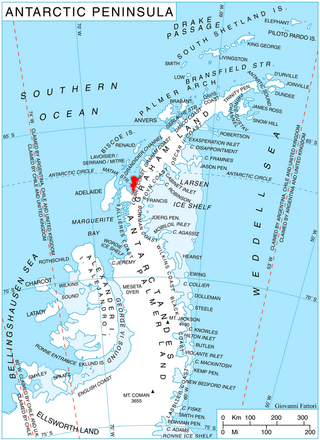Arizona | |
|---|---|
Municipality and village | |
 | |
| Country | |
| Province | |
| Department | Gobernador Dupuy |
| Time zone | UTC−3 (ART) |

Arizona is a village and municipality in San Luis Province in central Argentina. [1]
Arizona | |
|---|---|
Municipality and village | |
 | |
| Country | |
| Province | |
| Department | Gobernador Dupuy |
| Time zone | UTC−3 (ART) |

Arizona is a village and municipality in San Luis Province in central Argentina. [1]

The Arctic Archipelago, also known as the Canadian Arctic Archipelago, is an archipelago lying to the north of the Canadian continental mainland, excluding Greenland and Iceland.
This is a list of the extreme points of the United Kingdom: the points that are farther north, south, east or west than any other location. Traditionally the extent of the island of Great Britain has stretched "from Land's End to John o' Groats".

The Pensacola Mountains are a large group of mountain ranges and peaks that extend 280 nautical miles in a northeast–southwest direction in the Transantarctic Mountains System, Queen Elizabeth Land region of Antarctica. They comprise the Argentina Range, Forrestal Range, Dufek Massif, Cordiner Peaks, Neptune Range, Patuxent Range, Rambo Nunataks and Pecora Escarpment. These mountain units lie astride the extensive Foundation Ice Stream and Support Force Glacier which drain northward to the Ronne Ice Shelf.

Belo Jardim a Brazilian municipality in the state of Pernambuco. It has an estimated population in 2020 of 76,687 and a total area of 647.7 km2. It is located at 608 meters above the sea level and 182 km away from the state capital, Recife.
Tacacoma is a town in the La Paz Department in Bolivia. It is the seat of the Tacacoma Municipality, the third municipal section of the Larecaja Province.
Las Tejas is a village and municipality in Catamarca Province in northwestern Argentina.
Pomancillo Este is a village and municipality in Catamarca Province in northwestern Argentina.
Pomancillo Oeste is a village and municipality in Catamarca Province in northwestern Argentina.
La Carrera (Catamarca) is a municipality in Catamarca Province in northwestern Argentina. It is located within the Greater San Fernando del Valle de Catamarca area.
Santa Rosa (Valle Viejo) is a municipality in Catamarca Province in northwestern Argentina. It is located within the Greater San Fernando del Valle de Catamarca area.

Ambergris Glacier is a glacier flowing south-southeast from Mount Sara Teodora between Chintulov Ridge and Valkosel Ridge to join Flask Glacier just west of Fluke Ridge in Aristotle Mountains on the east coast of Graham Land, Antarctica. One of several names in the area that reflect a whaling theme, it was named in 1987 by the United Kingdom Antarctic Place-Names Committee from the substance secreted by the sperm whale and used in perfumery.

Widdowson Glacier is a glacier situated between Drummond and McCance Glaciers and flowing into Darbel Bay south of Sokol Point, on the west coast of Graham Land.

Drummond Glacier is a glacier 10 nautical miles (18 km) long and 2 nautical miles (4 km) wide, on the west coast of Graham Land, situated south of Hopkins Glacier and flowing west-northwest between Voit Peak and Sherba Ridge into Darbel Bay east of Sokol Point.

The Hull Glacier is a glacier, about 35 nautical miles long, flowing northwest between Mount Giles and Mount Gray into Hull Bay, in Marie Byrd Land, Antarctica.

McCance Glacier is the 30-km long and 5 km wide glacier draining the Hutchison Hill area on the west slopes of Avery Plateau on Loubet Coast in Graham Land, Antarctica. It flows north-northwestwards along the west side of Osikovo Ridge, Kladnitsa Peak and Rubner Peak and enters Darbel Bay.
The Terra Firma Islands are a small group of islands lying 8 nautical miles north of Cape Berteaux, off the west coast of Graham Land in West Antarctica.

Renaud Glacier is a heavily crevassed glacier on the east side of Hemimont Plateau flowing southeast to enter Seligman Inlet between Lewis Glacier and Choyce Point, on the east coast of Graham Land. The glacier was first photographed by the United States Antarctic Service (USAS), 1939–41. Named by United Kingdom Antarctic Place-Names Committee (UK-APC) for Andre Renaud, Swiss glaciologist and chairman of the Swiss Glacier Commission, 1955–74.
Robillard Glacier is a narrow glacier flowing east-northeast and entering the north side of the head of Solberg Inlet, on the east coast of Graham Land. It was discovered by members of East Base of the United States Antarctic Service (USAS), 1939–41, and was photographed from the air in 1947 by the Ronne Antarctic Research Expedition (RARE), under Ronne, and charted in 1948 by the Falkland Islands Dependencies Survey (FIDS). It was named by Ronne for Captain George Robillard, U.S. Navy, of the legal section of the Bureau of Ships, who assisted in gaining Congressional support which resulted in procuring the expedition ship.
Rotz Glacier is a tributary glacier 9 nautical miles (17 km) long and 2 nautical miles (3.7 km) wide. It flows west from Wakefield Highland, central Antarctic Peninsula, into Airy Glacier at a point due south of Mount Timosthenes. Photographed by Ronne Antarctic Research Expedition (RARE) on November 27, 1947. Surveyed by Falkland Islands Dependencies Survey (FIDS) in December 1958 and November 1960. Named by United Kingdom Antarctic Place-Names Committee (UK-APC) after Jean Rotz, 16th century French chartmaker and writer on the principles of navigation, who designed an elaborate magnetic compass and became hydrographer to King Henry VIII in 1542.